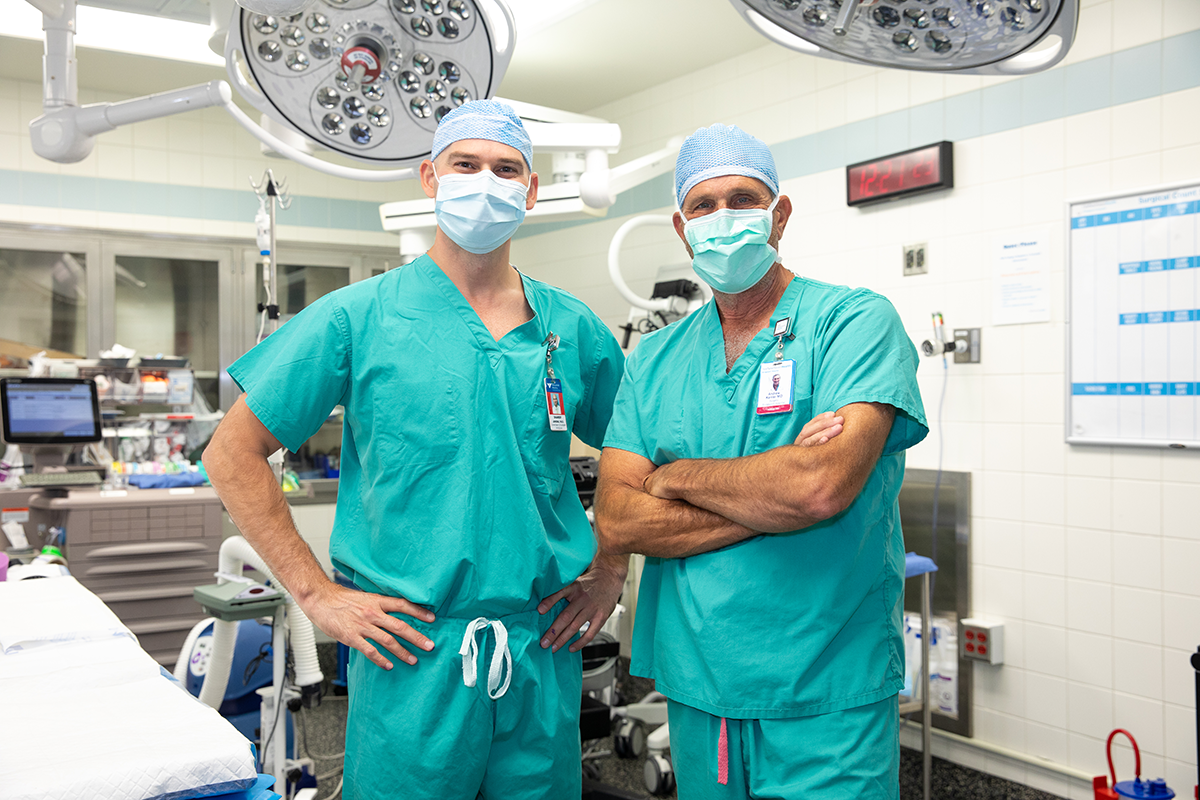-
Services
Featured Specialties
-
Locations
Location Type
-
Patients & Visitors
Published October 31, 2022

A breast cancer diagnosis can be overwhelming. But decisions surrounding breast cancer surgery and reconstruction don’t have to be – not when you have a team of surgical experts to guide you.
“Surgery is one of the three pillars that we use to treat breast cancer,” said Andrew Kenler, MD, a breast cancer surgeon with Northeast Medical Group. He and his colleague, plastic surgeon Shareef Jandali, MD, have been guiding women through their surgical options – and breast cancer-related surgeries – for the past 11 years at Bridgeport Hospital and the Smilow Cancer Hospital Care Center in Trumbull.
“Most often, surgery occurs before any other therapy, but in maybe a third of patients, we give chemotherapy or some form of systemic therapy first, and then surgery,” he said. “Stage 1, 2 and 3 breast cancers are all operable breast cancers. Patients with Stage 4 cancer, which is metastatic to a solid organ, such as liver, brain or bone, are typically not offered surgery.
“As a breast cancer surgeon, I think the most important thing to understand upfront is that you have two operations to treat your breast cancer,” Dr. Kenler said. “The important point, first and foremost, is that survival is the same, which begs the question: ‘How do I decide which operation is appropriate for me?’ And that’s why we spend hours upfront with these women helping them make good decisions for themselves.”
“You’re either going to get a lumpectomy – a breast-conserving surgery with radiation therapy, or you’re going to have a mastectomy – a surgical removal of all breast tissue,” Dr. Jandali said. “A lot of women choose double-mastectomy – the surgical removal of both breasts – because there are a lot of genetic mutations that have been discovered in the last 10 years, and more are discovered every year. Depending on which path you choose, considerations are then made to the reconstruction surgery.
“Usually, reconstruction is not completed in one stage,” Dr. Jandali explained. “It’s hard to re-create a perfect breast in one surgery, so most women will need a revision surgery afterwards. Another consideration is whether the patient is going to need radiation therapy, because that affects timing of reconstruction as well.”
All patients undergoing lumpectomy (or partial mastectomy) are offered an oncoplastic breast reconstruction. “It’s not just ‘remove the cancer and leave a divot,’” Dr. Kenler said. “It’s ‘remove the cancer and Dr. Jandali fills the defect with the patient’s own breast tissue.’ It’s a revolutionary technique that we have been doing now for well over a decade. It prevents patients from having a significant defect after lumpectomy, which is not easily fixed, especially after women get radiation therapy.”
“I would say they are definitely the top two,” Dr. Jandali said. A flap surgery involves taking a section of tissue from one area of your body – usually from the abdomen – to create a new breast mound. Breast implants, which are silicone devices filled with silicone gel or salt water (saline), can also be used to reshape the breasts after mastectomy.
A third type of reconstruction developed in the last 10 years is called Goldilocks Reconstruction. Dr. Jandali noted that the procedure itself leaves women with a breast reconstruction that fits the adage in the story of Goldilocks and the Three Bears – “not too big, not too small, but just right.”
“The Goldilocks Reconstruction is really perfect for women who have large, low breasts,” Dr. Jandali explained. “What we do is take all of the extra skin and associated fat with it and fold it into a much smaller lifted breast. It’s great because it’s usually performed on an outpatient basis. Women can preserve their nipples, and it looks like they have a smaller B-cup breast afterwards. It’s perfect in older women and women who do not want implants.”
“Nipple-sparing mastectomy is a technique specific to women who are undergoing mastectomy,” Dr. Kenler said. “When possible, it involves preserving some of the skin, the nipple and areola after removing the breast tissue. Nipple-sparing mastectomy is performed now about 95 percent of the time.”
“One of the other things we do commonly is a nipple graft,” Dr. Jandali said. “This procedure increases our ability to do nipple-sparing in women with large or low breasts, where classically they just have their nipples removed at most places. That’s a huge advance. We’ve been doing them routinely for 10 years.
“The benefits are the cosmetic, but it also means less surgery,” Dr. Jandali noted. “Because if you need to reconstruct the nipple later, it’s another separate, small surgery. If you need to tattoo it, that’s another procedure. Tattoos need to be touched up every 10 years or so, so whenever you can preserve the nipple with its natural pigment and color, that’s a benefit.”
“For the majority of women who are interested in not only having their cancer cured but want to feel and look whole physically, emotionally and spiritually with reconstruction, we want them to know that the two things are not mutually exclusive,” Dr. Kenler said. “We can do that. We can cure your cancer and keep you looking great, feeling great and staying active.”
Learn more about cancer services at the Smilow Cancer Hospital, with Care Centers in Fairfield, Trumbull and Bridgeport.